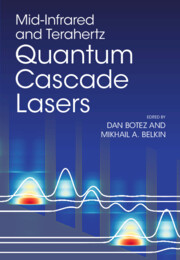Book contents
- Frontmatter
- Dedication
- Contents
- Preface
- Part I Bandstructure Engineering, Modeling and State-of-the-Art QCLs
- Part II Active Research Topics
- 7 Quantum Cascade Laser Frequency Combs
- 8 Frequency Noise and Frequency Stabilization of QCLs
- 9 Distributed-Feedback and Beam Shaping in Monolithic Terahertz QCLs
- 10 Metasurface-based THz Quantum Cascade Lasers
- 11 Terahertz Quantum Cascade Laser Sources Based on Intra-Cavity Difference-Frequency Generation
- Part III Applications
- Index
9 - Distributed-Feedback and Beam Shaping in Monolithic Terahertz QCLs
from Part II - Active Research Topics
Published online by Cambridge University Press: 25 August 2023
- Frontmatter
- Dedication
- Contents
- Preface
- Part I Bandstructure Engineering, Modeling and State-of-the-Art QCLs
- Part II Active Research Topics
- 7 Quantum Cascade Laser Frequency Combs
- 8 Frequency Noise and Frequency Stabilization of QCLs
- 9 Distributed-Feedback and Beam Shaping in Monolithic Terahertz QCLs
- 10 Metasurface-based THz Quantum Cascade Lasers
- 11 Terahertz Quantum Cascade Laser Sources Based on Intra-Cavity Difference-Frequency Generation
- Part III Applications
- Index
Summary
High-power terahertz quantum-cascade lasers (QCLs) are desired for a variety of applications in imaging and spectroscopy. The best performance at practical operating temperatures for single-mode terahertz QCLs is realized with metallic cavities due to a strong plasmonic mode confinement of the optical mode within the cavity. However, such plasmonic lasers suffer from poor beam shapes, low output power, and multi-mode spectral behavior. Development of distributed-feedback (DFB) techniques to improve spectral as well as modal properties becomes indispensable for terahertz QCLs to address targeted applications that typically require single-mode operation, frequency stability and specificity, and optimal far-field beam quality with single-lobed profile and low angular divergence. This chapter describes the theory, design methodologies, and key results from a sampling of a wide variety of DFB techniques that have been implemented in literature for monolithic terahertz QCLs with metallic cavities in both edge-emitting and surface-emitting configurations, either of which have their specific application areas and advantages much-like that for infrared diode lasers.
Keywords
- Type
- Chapter
- Information
- Mid-Infrared and Terahertz Quantum Cascade Lasers , pp. 275 - 309Publisher: Cambridge University PressPrint publication year: 2023

